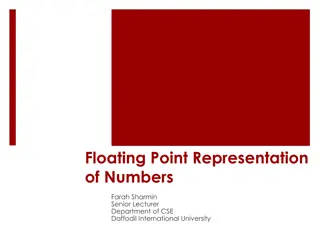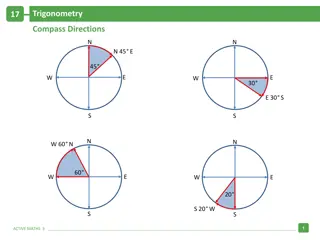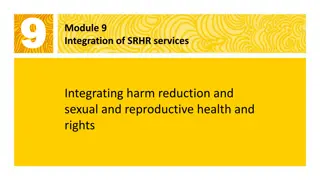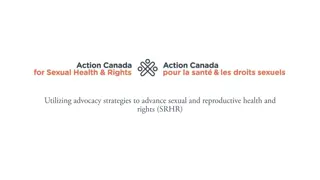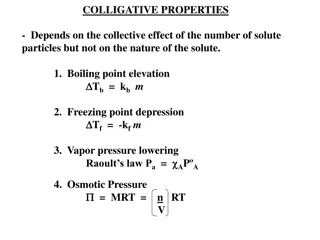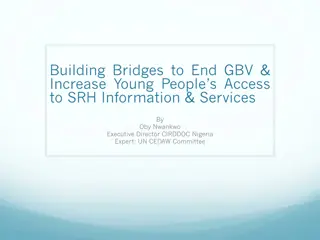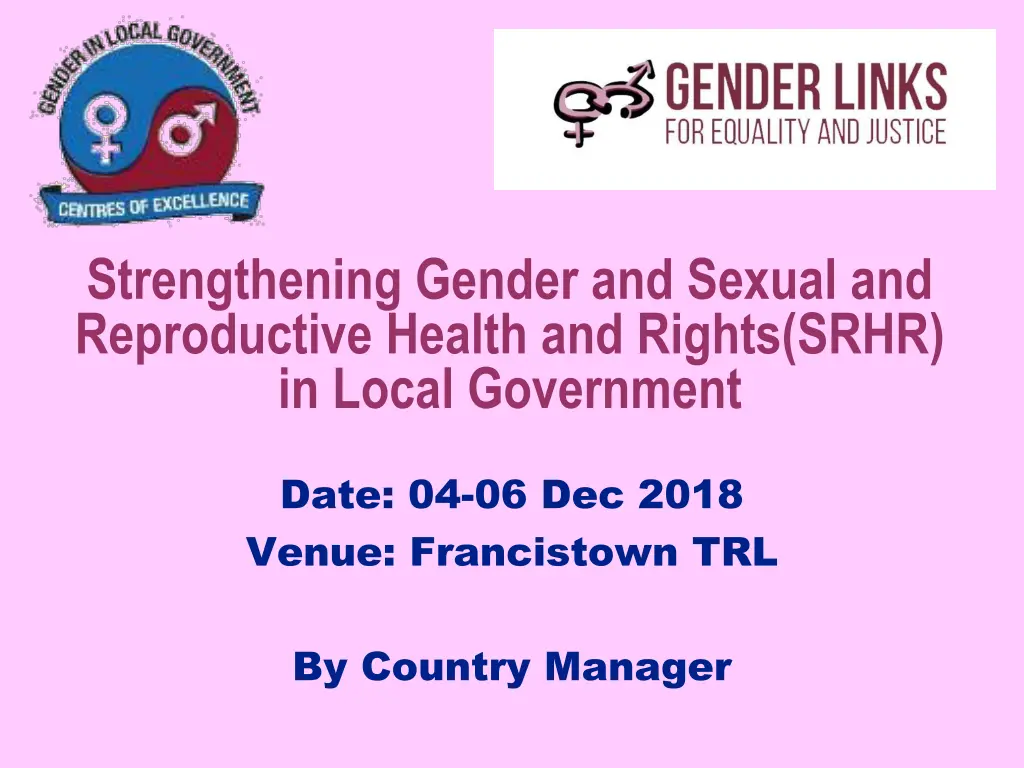
Enhancing SRHR through Body Mapping: A Creative Approach
Explore the transformative power of body mapping in strengthening Gender and Sexual and Reproductive Health and Rights (SRHR) initiatives at the local government level. Discover how body maps serve as therapeutic, research, advocacy, and team-building tools, fostering deeper communication and reflection among participants.
Download Presentation

Please find below an Image/Link to download the presentation.
The content on the website is provided AS IS for your information and personal use only. It may not be sold, licensed, or shared on other websites without obtaining consent from the author. If you encounter any issues during the download, it is possible that the publisher has removed the file from their server.
You are allowed to download the files provided on this website for personal or commercial use, subject to the condition that they are used lawfully. All files are the property of their respective owners.
The content on the website is provided AS IS for your information and personal use only. It may not be sold, licensed, or shared on other websites without obtaining consent from the author.
E N D
Presentation Transcript
Strengthening Gender and Sexual and Reproductive Health and Rights(SRHR) in Local Government Date: 04-06 Dec 2018 Venue: Francistown TRL By Country Manager
What did you learn? Did anything surprise you from your or other groups body maps? How did it feel doing the activity? Were there any issues that emerged in your group? Were any items on the body maps contentious? Are there any final comments?
Body maps can be broadly defined as life-size human body images, while body mapping is the process of creating body maps using drawing, painting or other art- based techniques to visually represent aspects of people s lives, their bodies and the world they live in Body mapping is a way of telling stories, much like totems that contain symbols with different meanings, but whose significance can only be understood in relation to the creator s overall story and experience
Body mapping has the potential to engage and enable its participants to communicate creatively through a deeper, more reflexive process.
Body maps may be used as: Therapeutic tool: to develop fresh insights, find new directions and to explore identity and social relationships Treatment information and support tool Research tool: body maps can be used in research. Advocacy tool Inter-generational dialogue tool Team building tool Art making tool Biographical tool
USE OF BODY MAPPING IN SRHR Body maps are used in sexual and reproductive health studies to explore sex and sexuality, risks and pleasures, and to understand individual's perceptions of their bodies and to encourage frank discussion about sexual behaviour. Body maps probe issues around sexual behaviour Body maps are used to enhance discussions around sexual behaviour.
Menstrual health Provision of menstrual products Water, sanitation and hygiene Fistula Sexual education and services Access to SRHR services Comprehensive sexual education Family planning and contraception Teenage pregnancies Sexual identity Homosexuality legal status Sexual identity Sex work Harmful practices Child marriages Female genital mutilation (FGM) Safe abortion Abortion laws Access abortion services SRHR HIV and AIDS Post Exposure Prophyllaxis(PEP) Prevention of mother-to- child-transmission (PMTCT) Anti retroviral coverage (ARV) Comprehensive knowledge of HIV Maternal health Maternal mortality Family planning and contraception Ante-natal care Post-natal care Fertility Cervical and breast cancer Gender based violence (GBV) GBV laws and policies GBV attitudes GBV action plans Trafficking of persons
Why is SRHR a local government issue? GROUP WORK Six groups. Each group must focus on one case study. Review the case studies. Identify the key SRHR issues for local government that emerge from the case studies using the guiding questions.
Questions 1. What are the key SRHR issues highlighted in the case study? 2. Why is it important to address these issues? 3. What strategies are being used to address these issues? 4. Does your Council face similar issues? 5. How can you use these strategies in the Council?
Adolescent and Youth Reproductive Health (AYRH) Barriers to accessing SRHR How can the problem be addressed?
FACTS More than a quarter of the world s population is between the ages of 10 and 24, with 86% living in less developed countries. These young people are tomorrow s parents. The reproductive and sexual health decisions they make today will affect the health and wellbeing of their communities and of their countries for decades to come. Family planning and HIV/AIDS
Teenage girls are more likely to die from pregnancy-related health complications than older women in their twenties. Statistics indicate that one-half of all new HIV infections worldwide occur among young people aged 15 to 24. The World Health Organization (WHO) defines an adolescent as an individual in the 10-19 years age group and usually uses the term young person to denote those between 10 and 24 years.
Adolescence is a period of transition from childhood to adulthood during which adolescents develop biologically and psychologically and move towards independence Orphans, young girls in rural areas, young people who are physically or mentally impaired, abused or have been abused as children and those migrating to urban trafficked are more likely to have problems. The negative health adolescents can pass from one generation to the next areas or being consequences of
Services that should be provided for young people Information and counselling on sexual and reproductive health issues Promotion of healthy sexual behaviours Family planning information, counselling and methods of contraception (including emergency contraceptive methods) Condom promotion and provision Testing and counselling services for pregnancy, HIV and other STIs Management of STIs
Antenatal care (ANC), delivery services, postnatal care (PNC) and pregnant mother-to-child transmission (PMTCT) Abortion and post-abortion care Appropriate referral linkage between health facilities at different levels.
Setting up youth structures How are young people included in the Council s activities currently? Are there formal structures in place? If yes, how does it work? Would the concept of junior councils work in this context? If yes how can it be rolled out? If no, what are the main challenges? What other option can be used to include young people in Council activities? How should young people be organised to be part of Council s activities? Who will be the focal person/department that young people can liaise with? When, how regularly and where will the Council meet with young people?
Key populations Men having sex with men Sex workers Transgender persons People who are using drugs (PWUD) People in prisons
DISCUSSION How do we understand the group we are discussing? Does the Council consider this population in its programming? If yes, how are they included? If no, how can they be included?
Stigma and discrimination All key populations identified in this strategy face high levels of stigma and discrimination which impedes their access to health services, including HIV and SRH services. Key populations face stigma and discrimination in health care settings, the workplace, families, and within communities. A study focused on southern and eastern Africa found high levels of stigma and discrimination against gay men and other MSM. This is also the case for sex workers and transgender persons. PWUD and people in prisons find it difficult to access services due to stigma and discrimination.
Violence All key populations experience high vulnerability to violence. Lesbians, MSM, female sex workers and transgender persons are likely to face gender- based violence because either they defy gender norms or are women. Due to their vulnerability and experience of police abuse, trans persons are less likely to approach law enforcement or health services for necessary assistance. Sex workers in southern Africa have reported a fear of and routine police abuse including sexual violence and beatings.
Lack of a protective legal and policy environment The environment populations ability to access services. As of 2015, approximately half of SADC Member States have specific laws criminalising consensual, same-sex relationships between adults and some aspect of sex work. These punitive laws render MSM and sex workers vulnerable to enforcement and others. lack of a protective significant legal obstacle and policy to is a key violence from law
Lack of data There is a dearth of information on the needs of key populations in SADC making it difficult to provide effective programming. There is almost no data regarding young key populations, transgender persons, people in prisons and PWUD in SADC. Though most countries in SADC have some data regarding HIV prevalence among MSM and sex workers, the type of detailed information does not exist in many SADC countries.
Lack of programming, funds and services aimed at key populations In SADC, there continues to be limited funds dedicated to programming specifically for key populations and thus, minimal services effectively addressing the needs of key populations. Most countries do not dedicate populations. No country in SADC allocates specific funds for addressing the HIV needs of transgender populations as part of their HIV expenditure resulting in limited programming transgender persons. funds for key tailored for
SRHR Planning Category Baseline What you need to do? If the Council is already engaged in an activity what statistics are in place. Add these in the relevant cells in the table. These are measures that show that progress has been made. What will be the evidence that the indicator has been achieved? Who will the council be targeting for the activity? Ensure that the key populations including men having sex with men (MSM), sex workers, transgender persons, people who are using drugs (PWUD) and people in prisons are part of your target populations. Indicators Means of verification Target groups including key populations What will the council do to address the different areas? Who will implement the actions? When will it occur? How much will be allocated to the activity? Actions Who Timeframe Budget in local currency Where to find this in the Council action plan In the next segment of the workshop, we will be integrating gender action plans into the council s existing plans. Its important to start identifying now how the SRHR plan will be reflected in the council s overall plan.
Menstrual health; Comprehensive SRHR information and services; Maternal health; Key populations






